Small things now come in big packages.
The Genesis G80 – which is a big sedan – used to be available with a big V8. It now comes standard with a small four. The same is true of its main rivals, the BMW 5-Series and Mercedes E-Class sedans. Also the Audi A6 and Cadillac CT5. Cars in this class used to come standard with sixes, too – just like the Genesis did.
They no longer do.
The reason for it is interesting because it’s not customer demand for four cylinder engines in big luxury sedans like the G80 and its rivals. More on that follows.
And the good news – in the case of the G80 – is that not all the news is small. A bigger V6 is now optional and it has two turbochargers and makes more power than last year’s optionally available V6.
Which isn’t bad news, at all.
The G80 is the second biggest sedan offered by Hyundai’s luxury division, Genesis – slotting in just behind the flagship G90. It is about the same size as its primary rivals, the BMW 5-Series and Mercedes E-Class sedans and – like them – it is based on a rear-drive layout with AWD available optionally.
Also like them – and all the others in its class – it now comes standard with a four cylinder engine.
The big difference is the G80’s four is larger – and much stronger – and its price tag is much lower.
It stickers for $47,700 to start – $50,850 with the optional AWD system – vs. $54,200 to star for the 5-Series sedan and $54,250 for the Benz E-Class sedan.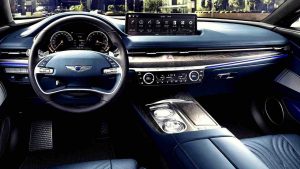
The G80 also comes standard with a bigger – 2.5 liter vs. 2.0 liter – four cylinder engine that makes 300 horsepower . . . vs. the 2.0 liter fours in the BMW and Benz that make 248 and 251 horsepower, respectively.
The Cadillac CT5’s 2.0 liter four only makes 237 hp.
You can also upgrade the G’s boiler room to a 3.5 liter V6 that makes 375 horsepower.
The rear-drive G80 so equipped stickers for $59,100; with the optional AWD system, the price rises to $62,250.
In addition to its new engines, the ’21 G80 also gets an updated look and new tech, including Evasive Steering Assist – a system that one-ups the more common “hit the brakes” automated collision avoidance systems that try to stop the car before it hits something. This one helps the driver steer around what it may otherwise be about to hit.
What’s Good
Larger, stronger standard engine than comes standard in more expensive rivals like the BMW 5 and Benz E.
Generous rearseat legroom (38.7 inches) vs. those rivals.
Standard heated rear seats and steering wheel in AWD-equipped versions.
What’s Not So Good
Much smaller (and a bit less powerful) standard engine than before.
The larger/much stronger optional V6 bumps the price up by more than $11k.
Safety tech can be overly peremptory.
The G80 used to come standard with 3.8 liter, 311 horsepower V6 – which made the G80 the biggest-standard-engined sedan in the class as well as something of a throwback to to the Before time – when cars in this class always came standard with at least a V6.
Because people who spent $50k and up on a big luxury sedan like the G80 or the BMW 5 and the Benz E expected to get a bigger engine than the fours that come standard in economy/family sedans that cost half or less as much.
The G80 and its rivals are now fitted with four as their standard engines – not because people who spend $50k-plus on such cars are demanding them but because the government is all-but-formally requiring it. The fours – being smaller than sixes – use a bit less gas and so emit a bit less gas. MPGs and C02 “emissions” are the nooses being tightened around the neck of the internal combustion engine – so as to make sure the functionally inferior electric car motor replaces it. 
But the buyers of $50k sedans still expect power – and Genesis continues to provide that.
The formerly standard 3.8 liter V6 has been replaced by a 2.5 liter four – with a turbo – to boost the power to 300, almost as much power as the previously standard 3.8 liter V6 made (and more torque, which makes up for the 11 horsepower lost). This engine is much more potent than the much smaller 2.0 liter turbocharged fours that come standard in the BMW 5 (248 hp) and Benz E (255 hp) which are only slightly more potent than the fours that come standard in $25k sedans like the Toyota Camry (2.5 liters, 206 hp) and no more potent than the fours which are available in $30k cars like the Honda Accord (2.0 liters, 252 hp).
Rear-wheel-drive is still standard in the G80 and its rivals – and a major point of difference between cars in this class and cars in the economy-family car class. 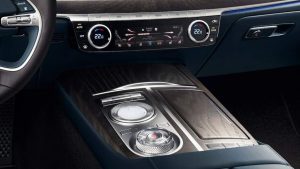
You can opt for all-wheel-drive, too – another feature that most non-luxury-branded sedans don’t offer at all.
If you want more cylinders – and much more power – the G80 is available with a new 3.5 liter V6 with two turbos. It replaces the previously available 3.3 liter turbocharged V6, which made 365 horsepower. This new V6 makes 375 horsepower – much more horsepower than the BMW 5’s optional (and smaller) 3.0 liter six, which only makes 335 horsepower. The Benz E’s optional mild-hybrid six makes nearly as much power (369 hp) but at a cost – in terms of choice.
And Benz only offers the six with 4Matic all-wheel-drive, which also adds to the price tag. Genesis gives you the choice – to buy AWD or not. And doesn’t charge you extra for not wanting the AWD.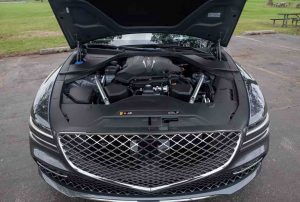
Both of the G80’s engines are paired with the same eight speed automatic transmission but the 2.5-equipped version is paired with a more aggressive (3.90 vs. 3.53) final drive ratio to get it going more quickly.
Sadly, the G80’s previously available 5.0 liter V8 – which made 430 horsepower and cost massively less than the still-available V8 powered versions of the Benz E and BMW 5 – no longer is.
You can thank Uncle for that.
On The Road
There is nothing bad to say about the power – or performance – of the G80’s new standard four. Its boosted 300 horsepower is enough to make it move like a $50k luxury-sport sedan ought to move. It gets to 60 in under six seconds, which puts four cylinder-powered economy/family sedans in the rearview, receding quickly.
But it doesn’t sound like a six – and that could be a problem for this $50k luxury-badged sedan.
It has been a problem for BMW, which has had to resort to artificial sound enhancement to make its four sound less like one.
The G80 hasn’t got auditory enhancement, so when you floor it – your hear the sound of a four. Which would sound better, arguably, if you could hear the sound of the turbocharger that boosts the power to V6 levels of power. But there’s no whistle, no wastegate pop. These have been purposely muted. Which is a shame, I think, because it would make this four sound better than the just-a-fours that power lesser-priced sedans.
The optional six needs no enhancement. It sounds appropriate – and performs even more appropriately. So equipped, the G80 almost breaches the 5 second barrier to 60.
Interestingly, the gas mileage difference between the G80’s standard four and optional V6 engines is negligible. The four rates 23 city, 32 highway with rear-wheel-drive and 22 city, 30 highway with the optional AWD system. The much stronger – and larger – V6 rates 19 city, 27 highway with rear drive and 18 city, 26 highway with AWD.
At the $50k-plus price point, 2-4 MPG either way is not much of a difference.
It is also about the same difference vs. the previous G80’s standard 3.8 liter V6. which rates 18 city, 26 highway for the rear-drive version.
But the difference is a big one as far as dealing with the government and its regulations is concerned. And that is why all of the big cars in the G80’s class now come standard with fours rather than the sixes they used to come standard with.
No matter what’s under the hood, there’s a big difference in the cabin – vs. cars with fours that cost $25k.
As there damned well better be.
The G80 feels like a $50k car. It is solid, like a safe in a Pullman car. It also sounds like a $50k car in that you hear little, except what’s on the excellent (and standard) 12 speaker audio rig. Or – if you prefer – the sounds of gentle rain or crackling fire – which you can dial those sounds up (literally) using the rotary/push control knob on the center console. The G80 offers a plethora of such sounds – with accompanying “themes,” visuals displayed on the also standard 14.5 inch LCD touchscreen. Which you can touch/tap to engage the various functions, if you prefer not to use the rotary/push control knob on the console.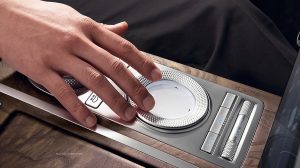
There is also a rotary gear selector knob that’s finished in beveled crystal. It looks very swanky – especially at night, because it’s LED backlit. But it’s not as feel-friendly as a less swanky but more intuitive gear-selector lever that has detents for Park and Drive and so on. But then, all the cars in this class have “e” input devices. It’s the in-thing and so there you go.
Also like all the cars in its class, the G80 comes standard with a lot of driver “assistance” tech. Including a collision-avoidance system that sometimes triggers (dashboard lights flash, beeps sound) in an overly peremptory manner. A car ahead is slowing to turn off thew road; you – the driver – can see that the other car will be gone by the time your car gets there. Maybe you cover the brake pedal, just in case. But you don’t apply it – because you can see it’s not necessary.
The car’s cameras, sensors and computer sometimes disagree. The good news is the system can be adjusted to be less peremptory or turned off altogether.
The new G80 looks a lot like the G90 – the biggest car Genesis offers. They both get a more dramatic-looking front end anchored by an inverted trapezoid-themed grille, flanked by tiered LED slit headlights. A Bentley-looking winged badge is pressed into the hood, just behind the leading edge of the grill.
Though the same size as its main rivals, the G80 is a bit . . . bigger where it counts. On the inside. Particularly in the back seat area, where there’s 38.7 inches of legroom for passengers vs. 36.2 in the Benz E-Class sedan and 36.5 inches in the BMW 5 sedan. The G also comes standard with bigger amenities – including the previously mentioned 12 speaker audio system and the 14.5 inch LCD touchscreen, which is bigger than the 12.3 inch touchscreens that come in the BMW 5 and Benz E.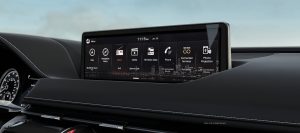
Because it comes very well-equipped, there are fewer options. Just two major packages – Advanced and Prestige. The former includes a 21 speaker Lexicon audio system, panorama sunroof, three-zone climate control, wood trim, power rear sunshades and 19-inch wheels. The latter includes soft-close doors, a surround-view camera system, upgraded leather seats and – one of the few things this car doesn’t come standard with that it probably ought to given the class it’s in – a wireless phone charger.
One thing that’s small about all the cars in this class is the trunk. Just 13.1 cubic feet. The same small size as the trunk of the Benz E-Class and only slightly smaller than the BMW 5’s 14.0 cubic foot trunk.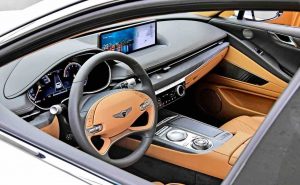
Arguably, this is the chief reason for sedans not selling as well as they used to. Even big ones, like this one.
Big cars used to have big trunks; anyone Gen X or older will remember the joke about how many bodies rolled up in carpet you could fit in the trunk of a Cadillac. But even Cadillacs are relatively small by today’s car standards – and their trunks about the same size as compact-sized cars’s trunks.
The reason for this has to do with aesthetics as much as government – as far as things getting smaller under the hood.
Big cars used to have long hoods – and long trunks to match. It was necessary for proportionality and it happened to be functional, too. But modern cars – even big sedans – have comparatively short overhangs, front and rear. The engines are smaller – and packaged tighter. The rears get smaller, to match.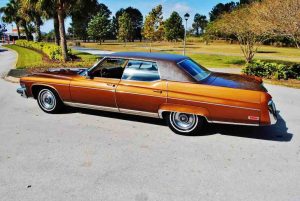
But the end result is a less practical car and – let’s face it – a less impressive-looking car. Once upon a time – in the Before time – big cars owned the road. They were the totems of arrival; if you owned one – you knew you’d made it.
Today’s analogs are very nice cars – but they’re lacking the throw-weight of the great battleships of the Before time.
The Rest
Other than the small trunk – and the smallness under the hood – it’s hard to come up with much to fault about this car. It’s sad the six is now optional – but it’s impressive that the G80’s new four retains the power of a six, something its main rivals haven’t been able to do.
At least, not without charging you more.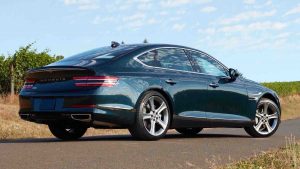
And even then, not giving you as much.
The Bottom Line
Hyundai ate Honda and Toyota’s lunch by doing to them what they did to GM and Ford – sell a better value (at first) and then a better car, for less – with a much better warranty. Genesis – Hyundai’s luxury division – aims to do the same to BMW, Benz and the rest . . . by doing the same thing, all over again.
. . .
Got a question about cars, Libertarian politics – or anything else? Click on the “ask Eric” link and send ’em in!
If you like what you’ve found here please consider supporting EPautos.
We depend on you to keep the wheels turning!
Our donate button is here.
If you prefer not to use PayPal, our mailing address is:
EPautos
721 Hummingbird Lane SE
Copper Hill, VA 24079
PS: Get an EPautos magnet or sticker or coaster in return for a $20 or more one-time donation or a $10 or more monthly recurring donation. (Please be sure to tell us you want a magnet or sticker or coaster – and also, provide an address, so we know where to mail the thing!)
My eBook about car buying (new and used) is also available for your favorite price – free! Click here. If that fails, email me at [email protected] and I will send you a copy directly!


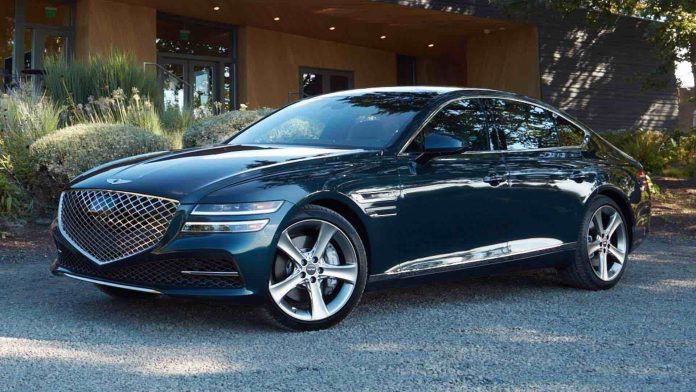


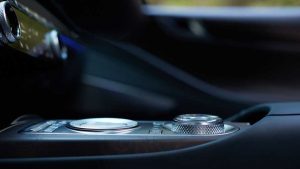
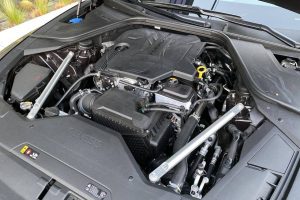









Why would Genesis GAF about fuel economy? Even if they get hit with the gas guzzler tax, that’s not going to stop the buyer from spending that kind of money on the car. If you can spend $50K-$60K or more on a car, what’s a few thousand more?
This is a beautifully proportioned car.
I like also how they paid attention to the switchgear. This is something other upstart luxury brands (Cadillac, Lincoln) like to cheap out on.
Great review Eric.
I’m a sucker for that long wheelbase look with the fronts more forward than typical FWD layouts.
I always thought that the Korean’s would end up hurting the Japanese and German cars a lot more than they have. They look almost identical now.
I wouldn’t hesitate owning one of these if I ever go back to ‘sedan and crappy pickup ownership’.
I just checked my local dealer, they have 9 of these in stock and all of them are AWD, and last time I was interested they would not order me a RWD, so I went 300 RWD V8, and glad I did.
Thanks, Chris!
This is a very nice car; it’d be even nicer with the V8 – which I am hoping Genesis can find a way to resurrect…
Looks like the G90 still has the optional V8, but of course it is over 75k. I didn’t think the G80 ever offered one.
I’ll wait for the 55 inch widescreen with 18 speaker soundbar for my next ride.
2021 Genesis GV80 pricing for Australia
Prices exclude on-road costs
GV80 2.5T RWD: $90,600
GV80 2.5T AWD: $95,600
GV80 3.0D AWD: $103,600
GV80 3.5T AWD: $108,600
2021 Genesis GV80 to launch in Australia with three engines: two petrol, one diesel
Rear- and all-wheel-drive options available, depending on specification
All models equipped with an eight-speed automatic transmission
Prices ranging from $90,600 to $108,600 plus on-road costs
Australian pricing for the new 2021 Genesis GV80 SUV has been announced, ahead of its showroom arrival in October 2020.
The upstart Korean luxury brand – a spin-off of the Hyundai brand – will offer its BMW X5-rivalling large SUV in a choice of four variants, each offering similar levels of standard equipment – but with the option of a $10,000 Luxury Package.
Opening the range is the GV80 2.5T, priced from $90,600 plus on-road costs, with two other powertrains available up to the $108,600 3.5T flagship.
The entry-level GV80 2.5T is powered, as its name suggests, by a 2.5-litre turbocharged four-cylinder petrol engine, producing 224kW and 422Nm. Drive is sent exclusively to the rear wheels through an eight-speed automatic transmission.
NOTE: Australian fuel consumption figures for the GV80 line-up will be confirmed closer to October.
2021 Genesis GV80 2.5T standard equipment
20-inch alloy wheels
14.5-inch infotainment touchscreen with Apple CarPlay, Android Auto, digital radio and augmented reality satellite navigation
Handwriting recognition for entering navigation addresses
12-way power-adjustable, heated and ventilated front seats with memory and four-way lumbar support
‘Genuine’ leather upholstery
Open-pore wood trim
Panoramic sunroof
Ambient LED cabin lighting
Dual-zone climate control
21-speaker Lexicon premium sound system
Wireless phone charging
12-inch head-up display
Hands-free electric tailgate
Keyless entry with push-button start
Remote Start (via the key fob)
Electric reach/height-adjustable steering column
40:20:40 split-folding second row with sliding/reclining functionality
Retractable rear sun-blinds
The list of standard active safety technologies is equally plentiful, consisting of:
10 airbags, including one between the front passengers
Autonomous emergency braking with pedestrian and cyclist detection, and support for intersections
Adaptive cruise control with stop-and-go functionality and machine learning
Lane-keep assist
Blind-spot monitoring and rear cross-traffic alert with braking functionality
Safe Exit Assist (which prevents the rear doors being opened into oncoming traffic/cyclists)
High beam assist
Driver attention monitoring
Multi Collision Brake (which maintains brake pressure after an accident to prevent subsequent collisions)
360-degree camera
A ‘Luxury Package’ can be optioned across the range for a cool $10,000, adding:
12.3-inch digital 3D instrument cluster (details here)
18-way power-adjustable massaging driver’s seat
Power-adjustable, heated and ventilated second row
Heated steering wheel
Nappa quilted leather trim
Suede headlining
Adaptive LED headlights
Soft-close doors
Rear privacy glass
Tri-zone climate control
Low-speed reverse autonomous emergency braking
Remote automatic parking assist (via the key fob)
An all-wheel-drive version of the 2.5-litre four-cylinder can be had for an additional $5000, bringing the price to $95,600 plus on-road costs.
Along with the aforementioned all-paw system, it adds a third row of seats, which gains power adjustment when the Luxury Package is optioned.
Customers looking for a diesel model can opt for the GV80 3.0D AWD, priced from $103,600 plus on-road costs.
Under the bonnet is a new 3.0-litre turbocharged inline-six diesel engine, sending 204kW and 588Nm to all wheels through an eight-speed automatic.
Standard equipment additions include adaptive dampers, an electro-mechanical rear limited-slip differential and 22-inch alloy wheels wrapped in 265mm-wide Michelin tyres.
Sitting atop the range is the $108,600 GV80 3.5T AWD, powered by a 279kW/530Nm 3.5-litre twin-turbocharged V6 petrol engine mated to an eight-speed automatic transmission and all-wheel-drive. The list of standard equipment is identical to the cheaper diesel model.
Eight gloss and three matte exterior paint colours will be offered across the range, the latter commanding a $2000 premium. Genesis’ five-year, unlimited-kilometre warranty is standard.
The 2021 Genesis GV80 will make its Australian debut in October.
https://www.caradvice.com.au/873255/2021-genesis-gv80-price-and-specs-luxury-suv-on-sale-from-october-this-year/